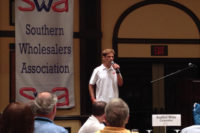This is the second of a two-part series on the steps United States-based employers should take to comply with the revised OSHA Hazard Communication Standard, also known as OSHA HCS 2012. Part 1 addressed OSHA HCS 2012 compliance for U.S.-based employers, particularly wholesalers and distributors. Part 2 addresses additional compliance requirements for manufacturers of chemical products and articles.
Whether you are a manufacturer, blender, wholesaler, distributor or downstream customer, the U.S. OSHA Hazard Communication Standard requires employers to provide its employees and chemical users barrier-free access to current material safety data sheets for all hazardous chemicals in the workplace.
OSHA’s final rule to align the HCS with Revision 3 of the United Nations GHS went into effect May 12, 2012. U.S. employers must train their employees on the GHS elements and revised safety data sheet format by Dec. 1, 2013, OSHA’s first phase-in date for employer compliance with the final rule.
The underlying principle of GHS is the same set of rules for classifying hazards and the same general format and content for SDSs and labels are adopted and used around the world. Under OSHA HCS 2012, labels issued by chemical manufacturers and importers must include the applicable GHS signal word, GHS pictogram(s), physical and health hazard statements, and precautionary statements.
The required SDS format specifies a 16-section heading, the order of information and the information provided under those headings. Companies that manufacture, blend or distribute specialty chemicals or produce manufactured articles requiring SDSs, must ensure their U.S. SDSs comply with the revised HCS by June 1, 2015.
Five critical tasks
As the June 2015 deadline to re-author SDSs under OSHA HCS 2012 is quickly approaching, the manufacturer should plan today to:
·Identifythose products shipped within and outside the U.S.;
·Confirmthe finished product’s composition, along with its physical and chemical data;
·Educatein-house personnel involved in the SDS authoring process;
·Buildan internal GHS substance library and determine mixture classifications for its finished products; and
·Ensurethe SDSs are updated regularly so they continue to comply with current chemical regulations.
Next, the manufacturer should assess its ability to properly reclassify its finished products and the substances that make up those products under HCS 2012, and then determine how much time is needed to complete both the reclassification process and re-author the SDSs.
In-house or outsource?
Several factors impact the overall cost of software ownership, including the base authoring software application, required regulatory databases and language modules, internal IT support, system implementation and maintenance fees, and ongoing training of SDS authors. How do these factors impact the manufacturer’s desired timeframe to re-author its SDS? Does the manufacturer have in-house access to regulatory chemists and other personnel ensure its authored SDSs are compliant with HCS 2012?
When evaluating SDS authoring services providers, manufacturers should assess where they ship their products, both now and in the future. A successful SDS and label-authoring partnership is dependent upon the manufacturer’s solid understanding of the service provider’s SDS authoring processes and the data required from the manufacturer in order to generate the finished product SDSs. Key questions to ask a potential provider should address the depth and breadth of the provider’s regulatory expertise to author SDSs and labels for the U.S. and the global marketplace and how trade secrets and proprietary data are addressed.
OSHA HCS 2012 compliance starts with the manufacturer starts with the manufacturer. More than 43 million U.S. employees are expected to benefit from the improved quality and consistency of hazard information in these updated SDSs through their enhanced comprehension of the hazards, resulting in improved worker health and safety.




